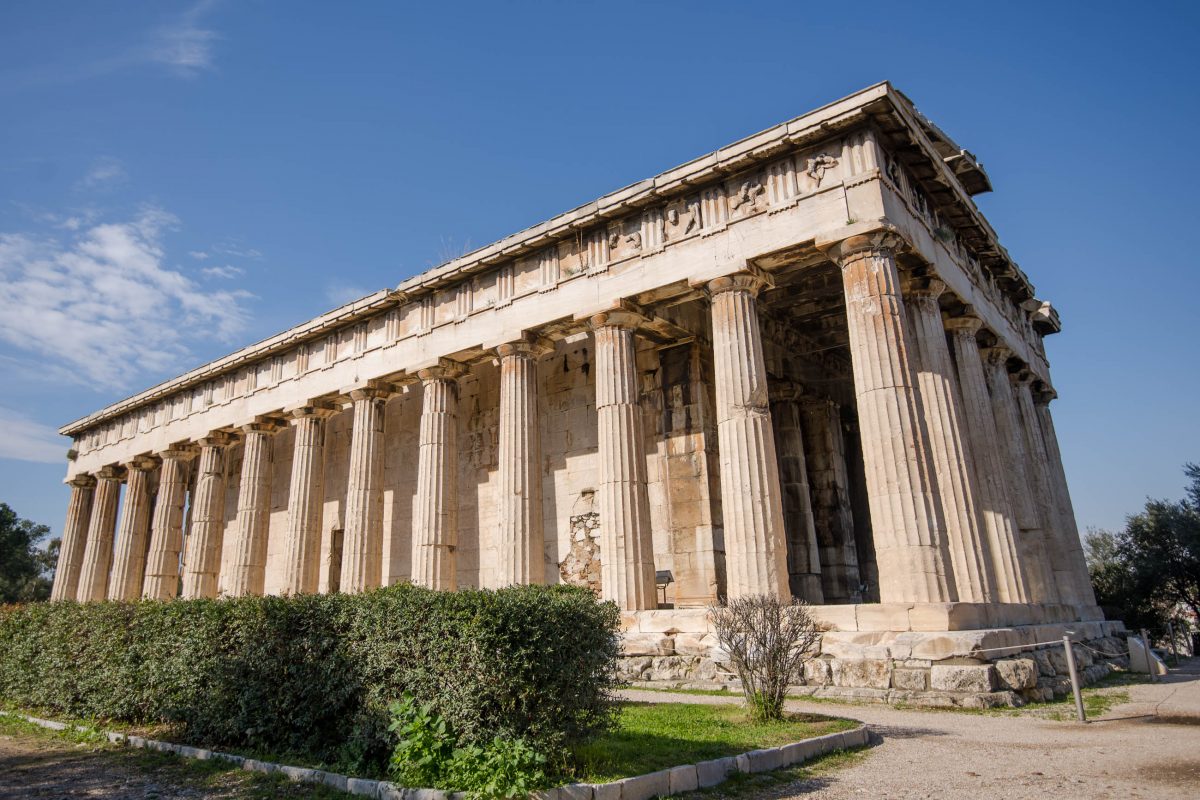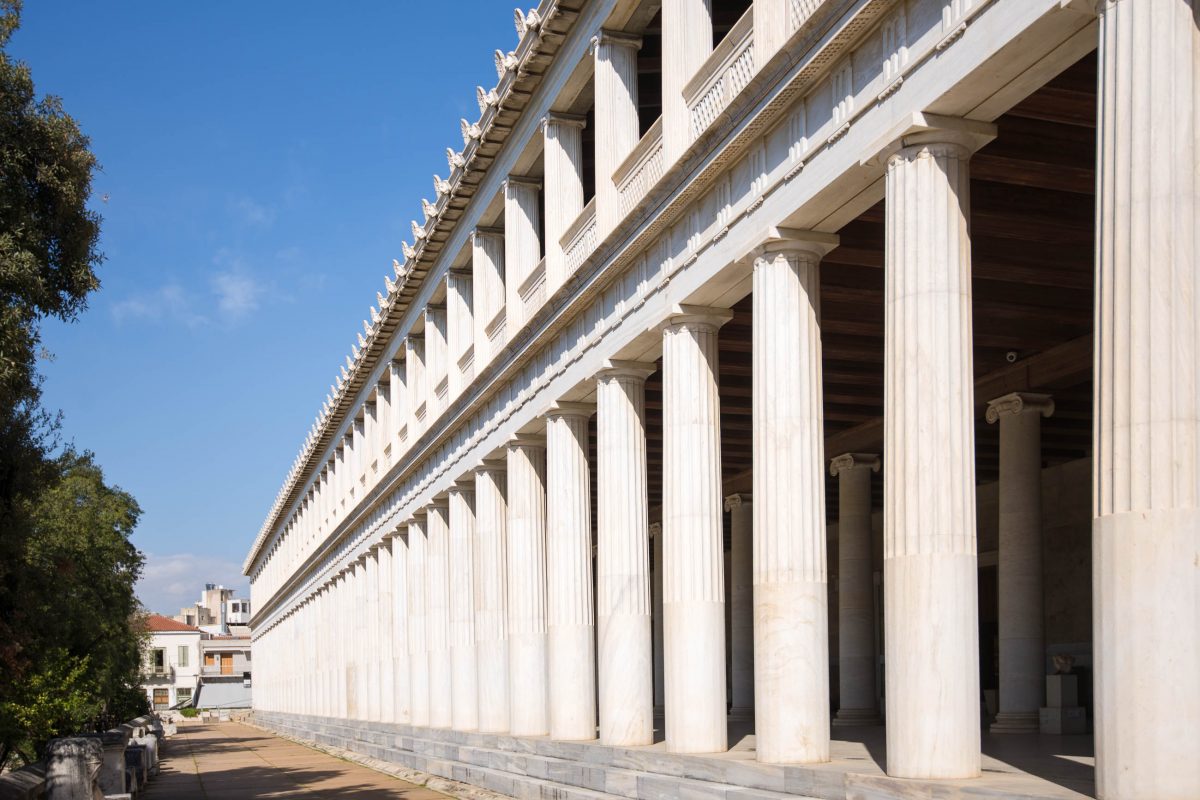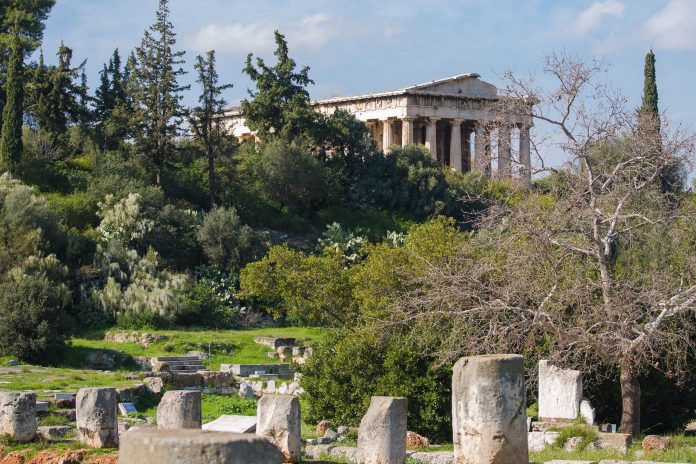Die Antike Agora war mehrere Jahrhunderte lang das wirtschaftliche und politische Zentrum von Athen. Heute mutete das üppig bewachsene Gelände mit den steinernen Überresten nahezu idyllisch an.
In der griechischen Antike war die Antike Agora am Fuß der berühmten Akropolis in Athen der zentrale Marktplatz der Hauptstadt Griechenlands. Hier gingen die alten Griechen nicht nur ihren Einkäufen nach, sondern erledigten auch verwaltungstechnische Geschäfte. So versammelten sich die Athener Bürger hier unter anderem zu den Wahlen und Abstimmungen der ersten Demokratie der Welt.
Der griechische Schreiber Eubulos hielt bereits im 4. Jahrhundert vor Christus fest, dass man auf der Agora so ziemlich alles erwerben konnte, von Äpfel und Trauben über Gesetze und Gerichtsvollzieher bis hin zu Zeugenaussagen und Beschuldigungen.
Tipp: Die Antike Agora ist nicht zu verwechseln mit der Römischen Agora, die nur wenige hundert Meter östlich der Antiken Agora liegt und vor allem durch den Turm der Winde auffällt.
BILDER: Antike Agora in Athen
Fotogalerie: Antike Agora in Athen
Sehenswürdigkeiten der Antiken Agora in Athen
Neben den öffentlichen Gebäuden befanden sich auf der Antiken Agora auch zahlreiche Heiligtümer. Dies ergaben die Ausgrabungen, die 1931 starteten. Archäologischen Erkenntnissen zufolge standen auf der Agora einst etwa 30 Bauwerke, die jedoch noch nicht alle mit einer Bedeutung versehen werden konnten. Heute sind nur noch zwei Gebäude der Antiken Agora erhalten.
Hephaistos-Tempel (Hephaisteion)

Der Hephaistos-Tempel auf der Antiken Agora wurde im 5. Jahrhundert vor Christus errichtet und dem griechischen Gott der Schmiedekunst und Schutzheiligen der Handwerker geweiht. Vielleicht ist sein Tempel deshalb bis heute fast vollständig erhalten.
Jede einzelne der 34 Säulen steht bis heute aufrecht und auch das Gebälk und große Teile des Daches sind noch original. Damit ist das Hephaisteion der besterhaltene Tempel in ganz Griechenland. Nachdem er ab dem 7. Jahrhundert bist 1834 als Kirche und anschließend als erstes archäologisches Museum von Athen diente, wurde er nie abgerissen.
Stoa des Attalos – Agora-Museum

Das zweite markante Gebäude auf der Antiken Agora ist die imposante Stoa des Attalos. Sie war bei weitem nicht so gut erhalten wie der Hephaistos-Tempel, wurde jedoch im Jahr 1955 von Archäologen rekonstruiert. Das eindrucksvolle Gebäude ist 116m lang und 20m breit und beherbergt heute das Agora-Museum.
Die ursprüngliche Stoa entstand etwa 150 vor Christus. In ihren weitläufigen Säulengängen wurde damals gehandelt, politisiert und philosophiert. Heute beherbergt das Museum in erster Linie Funde der Antiken Agora, unter anderem unzählige Tonscherben mit eingeritzten Namen, die für das so genannte „Scherbengericht“ verwendet wurden. Im Zuge dessen konnten die Athener Bürger mit Hilfe von Tonscherben einmal im Jahr abstimmen, welcher Politiker ein Jahr lang in die Verbannung geschickt wird.
Heilige Apostelkirche

An der südöstlichen Ecke der Antiken Agora befindet sich die byzantinische Kirche Agii Apostoli aus dem 11. Jahrhundert. Sie ist das einzig erhaltene Gebäude der Antiken Agora aus dem Mittelalter. Die schmucke Kirche wurde in den 1950er-Jahren rekonstruiert. Sie ist nicht besonders groß, weist jedoch eine interessante Architektur mit einem kreuzförmigen Grundriss auf. Im Inneren befinden sich ein marmorner Altar und Wandmalereien aus dem 17. Jahrhundert.
Tipp: Die Antike Agora ist im Kombiticket von Athen enthalten, welches zum ermäßigten Preis vier Tage lang für das Akropolis Museum, die Akropolis, die Antike Agora und ihr Museum, Kerameikos, das Dionysos-Theater, den Tempel des Olympischen Zeus und die Römische Agora gilt und bei jeder dieser Sehenswürdigkeiten erhältlich ist.





